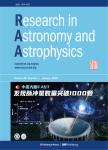版权所有:内蒙古大学图书馆 技术提供:维普资讯• 智图
内蒙古自治区呼和浩特市赛罕区大学西街235号 邮编: 010021

作者机构:Yunnan ObservatoriesChinese Academy of SciencesKunming 650216China Key Laboratory for the Structure and Evolution of Celestial ObjectsChinese Academy of SciencesKunming 650216China Center for Astronomical Mega-ScienceChinese Academy of SciencesBeijing 100101China Department of AstronomyKey Laboratory of Astroparticle Physics of Yunnan ProvinceYunnan UniversityKunming 650091China Key Laboratory of Dark Matter and Space AstronomyPurple Mountain ObservatoryChinese Academy of SciencesNanjing 210033China
出 版 物:《Research in Astronomy and Astrophysics》 (天文和天体物理学研究(英文版))
年 卷 期:2020年第20卷第4期
页 面:39-43页
核心收录:
学科分类:07[理学] 070401[理学-天体物理] 0704[理学-天文学]
基 金:supported by the National Key Research&Development Program of China(2018YFA0404203) the National Natural Science Foundation of China(Grant Nos.U1931204,U1738122,11761131007,11673060and 11433004) the International Partnership Program of Chinese Academy of Sciences(114332KYSB20170008) Top Talents Program of Yunnan Province,and the Natural Science Foundation of Yunnan Province(2016FB003 and 2018FY001(-003))
主 题:acceleration of particles supernovae:individual(Cassiopeia A) ISM:supernova remnants X-rays:ISM
摘 要:Cassiopeia A,the brightest radio supernova remnant(SNR)in the sky,has several unique characteristics in comparison to its *** its radio brightness and prominent soft-concave radio spectrum,itsγ-ray spectrum appears to have a low-energy cutoff near 2 GeV,and it is the only SNR with prominent hard X-ray *** the unusual radio properties may be attributed to strong emission from reverse shocks,the hard X-ray emission has been associated with high-speed inward shocks induced by high density ***,the low-energyγ-ray spectral cutoff could be attributed to slow penetration of lower energy particles accelerated near the inward shocks into high-density emission *** this paper,we carry out magneto-hydrodynamic(MHD)simulations of shocks in Cassiopeia A and demonstrate that its inward shock structure can indeed be reproduced via shock interactions with clumps of gases with a density of 20 cm-3.